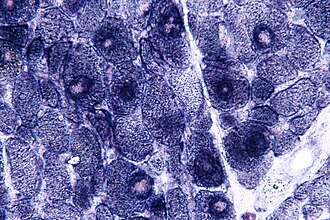Difference between revisions of "Succinate dehydrogenase"
Jump to navigation
Jump to search
| (4 intermediate revisions by the same user not shown) | |||
| Line 2: | Line 2: | ||
'''Succinate dehydrogenase''', abbreviated '''SDH''', is an enzyme complex in the citric acid cycle and electron transport chain. It is localized to the mitochondria. | '''Succinate dehydrogenase''', abbreviated '''SDH''', is an enzyme complex in the citric acid cycle and electron transport chain. It is localized to the mitochondria. | ||
==Immunostain== | |||
*It is used to look for mitochondrial disease. | |||
*Loss of staining is pathologic. | |||
==Associated pathology== | |||
Mutations in SDH genes are associated with: | |||
*[[Paraganglioma]].<ref name=pmid24500761>{{Cite journal | last1 = Vicha | first1 = A. | last2 = Taieb | first2 = D. | last3 = Pacak | first3 = K. | title = Current views on cell metabolism in SDHx-related pheochromocytoma and paraganglioma. | journal = Endocr Relat Cancer | volume = 21 | issue = 3 | pages = R261-77 | month = Jun | year = 2014 | doi = 10.1530/ERC-13-0398 | PMID = 24500761 }}</ref> | *[[Paraganglioma]].<ref name=pmid24500761>{{Cite journal | last1 = Vicha | first1 = A. | last2 = Taieb | first2 = D. | last3 = Pacak | first3 = K. | title = Current views on cell metabolism in SDHx-related pheochromocytoma and paraganglioma. | journal = Endocr Relat Cancer | volume = 21 | issue = 3 | pages = R261-77 | month = Jun | year = 2014 | doi = 10.1530/ERC-13-0398 | PMID = 24500761 }}</ref> | ||
*[[Pheochromocytoma]].<ref name=pmid24500761/> | *[[Pheochromocytoma]].<ref name=pmid24500761/> | ||
*[[Succinate dehydrogenase renal cell carcinoma]].<ref name=pmid23083876>{{Cite journal | last1 = Ricketts | first1 = CJ. | last2 = Shuch | first2 = B. | last3 = Vocke | first3 = CD. | last4 = Metwalli | first4 = AR. | last5 = Bratslavsky | first5 = G. | last6 = Middelton | first6 = L. | last7 = Yang | first7 = Y. | last8 = Wei | first8 = MH. | last9 = Pautler | first9 = SE. | title = Succinate dehydrogenase kidney cancer: an aggressive example of the Warburg effect in cancer. | journal = J Urol | volume = 188 | issue = 6 | pages = 2063-71 | month = Dec | year = 2012 | doi = 10.1016/j.juro.2012.08.030 | PMID = 23083876 }}</ref> | *[[Succinate dehydrogenase renal cell carcinoma]].<ref name=pmid23083876>{{Cite journal | last1 = Ricketts | first1 = CJ. | last2 = Shuch | first2 = B. | last3 = Vocke | first3 = CD. | last4 = Metwalli | first4 = AR. | last5 = Bratslavsky | first5 = G. | last6 = Middelton | first6 = L. | last7 = Yang | first7 = Y. | last8 = Wei | first8 = MH. | last9 = Pautler | first9 = SE. | title = Succinate dehydrogenase kidney cancer: an aggressive example of the Warburg effect in cancer. | journal = J Urol | volume = 188 | issue = 6 | pages = 2063-71 | month = Dec | year = 2012 | doi = 10.1016/j.juro.2012.08.030 | PMID = 23083876 }}</ref> | ||
*[[Gastrointestinal stromal tumour]]. | |||
==See also== | ==See also== | ||
*[[Immunohistochemistry]]. | *[[Immunohistochemistry]]. | ||
*[[Neuromuscular pathology]]. | *[[Neuromuscular pathology]]. | ||
*[[Carney-Stratakis syndrome]]. | |||
==References== | ==References== | ||
| Line 15: | Line 22: | ||
[[Category:Immunohistochemistry]] | [[Category:Immunohistochemistry]] | ||
[[Category:Molecular pathology]] | |||
Latest revision as of 15:18, 15 March 2016
Succinate dehydrogenase, abbreviated SDH, is an enzyme complex in the citric acid cycle and electron transport chain. It is localized to the mitochondria.
Immunostain
- It is used to look for mitochondrial disease.
- Loss of staining is pathologic.
Associated pathology
Mutations in SDH genes are associated with:
- Paraganglioma.[1]
- Pheochromocytoma.[1]
- Succinate dehydrogenase renal cell carcinoma.[2]
- Gastrointestinal stromal tumour.
See also
References
- ↑ 1.0 1.1 Vicha, A.; Taieb, D.; Pacak, K. (Jun 2014). "Current views on cell metabolism in SDHx-related pheochromocytoma and paraganglioma.". Endocr Relat Cancer 21 (3): R261-77. doi:10.1530/ERC-13-0398. PMID 24500761.
- ↑ Ricketts, CJ.; Shuch, B.; Vocke, CD.; Metwalli, AR.; Bratslavsky, G.; Middelton, L.; Yang, Y.; Wei, MH. et al. (Dec 2012). "Succinate dehydrogenase kidney cancer: an aggressive example of the Warburg effect in cancer.". J Urol 188 (6): 2063-71. doi:10.1016/j.juro.2012.08.030. PMID 23083876.
